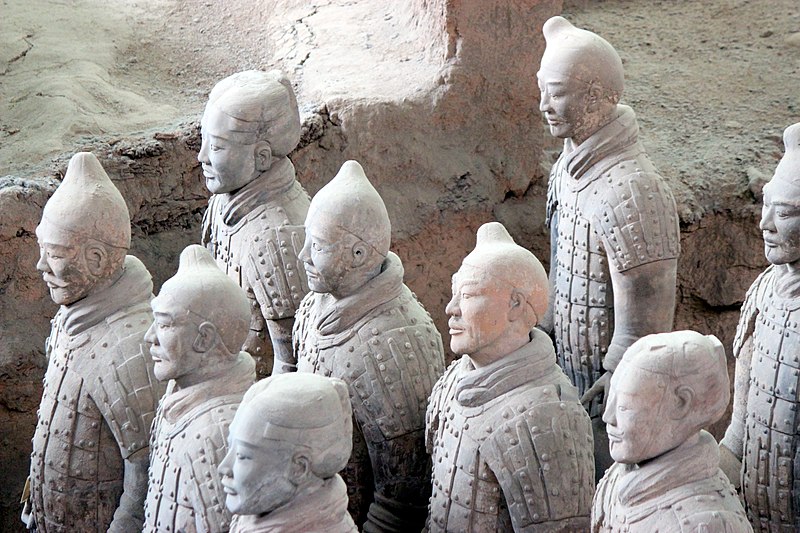Archaeology, the study of human history and prehistory through the excavation of artifacts and the analysis of material remains, offers a captivating journey into the depths of our past. From ancient civilizations to forgotten cultures, archaeological discoveries provide invaluable insights into the development of human societies, their beliefs, customs, and achievements. This introduction sets the stage for exploring ten of the greatest archaeological discoveries in history, each offering a fascinating glimpse into the rich tapestry of our collective heritage. Through these discoveries, we embark on a voyage spanning continents and millennia, uncovering the mysteries of lost worlds and the enduring legacy of human ingenuity.
1. Tutankhamun’s Tomb, Egypt
In 1922, British archaeologist Howard Carter made a historic discovery in Egypt’s Valley of the Kings: the tomb of Tutankhamun, a relatively obscure pharaoh of the 18th Dynasty. Sealed for over 3,000 years, the tomb revealed an astonishing array of treasures that captivated the world’s imagination. Among the remarkable finds was the golden death mask of Tutankhamun, one of the most iconic artifacts of ancient Egypt. Crafted with exquisite detail, the death mask adorned the mummified remains of the young pharaoh, symbolizing his eternal journey into the afterlife.
But the treasures within Tutankhamun’s tomb extended far beyond the famous death mask. The burial chamber contained a wealth of artifacts, including jewelry, chariots, furniture, and ceremonial objects, meticulously arranged to accompany the pharaoh on his journey to the next world. Each artifact offered insights into the religious beliefs, artistic techniques, and material culture of ancient Egypt during the New Kingdom period.
Tutankhamun’s tomb also provided valuable historical and archaeological information about the young pharaoh himself. Although Tutankhamun’s reign was relatively short-lived, his tomb offered clues about his lineage, reign, and the circumstances surrounding his death. The meticulous preservation of the tomb’s contents allowed researchers to reconstruct aspects of Tutankhamun’s life and the opulence of his burial, despite his historical obscurity.
The discovery of Tutankhamun’s tomb sparked worldwide fascination with ancient Egypt and fueled a renewed interest in archaeology and Egyptology. It remains one of the most celebrated archaeological finds in history, a testament to the enduring allure of Egypt’s ancient civilization and the mysteries that lie buried beneath its sands.
2. Rosetta Stone, Egypt
Discovered in 1799 during Napoleon Bonaparte’s military campaign in Egypt, the Rosetta Stone quickly became one of the most significant archaeological finds of all time. This ancient artifact, a dark grey-pink granodiorite stone slab, measures about 44 inches tall and 30 inches wide, and bears inscriptions in three scripts: Ancient Egyptian hieroglyphs, Demotic script, and Ancient Greek.
The significance of the Rosetta Stone lies in its role as the key to deciphering ancient Egyptian hieroglyphs, a writing system that had remained enigmatic and undecipherable for centuries. The text inscribed on the stone is a decree issued in 196 BCE by King Ptolemy V, commemorating his ascension to the throne and the establishment of his divine cult. The decree is repeated in three scripts, with the Ancient Greek portion serving as the key to unlocking the meaning of the hieroglyphic and Demotic texts.
The breakthrough in deciphering hieroglyphs came thanks to the efforts of French linguist and scholar Jean-François Champollion in the early 19th century. Using the Greek text on the Rosetta Stone as a starting point, Champollion painstakingly compared the hieroglyphic and Demotic inscriptions, identifying corresponding words and symbols. Through his groundbreaking work, Champollion successfully deciphered the hieroglyphic script, opening up a new era of understanding of ancient Egyptian language, history, and culture.
The decipherment of the Rosetta Stone had profound implications for Egyptology and the study of ancient civilizations. It allowed scholars to translate other inscriptions and texts, shedding light on the religious beliefs, political events, and everyday life of ancient Egyptians. The Rosetta Stone remains on display at the British Museum in London, where it continues to inspire fascination and curiosity about the mysteries of the past.
3. Lascaux Cave Paintings, France
Discovered in 1940 by a group of French teenagers exploring the hills near Montignac, the Lascaux Cave Paintings rank among the most remarkable prehistoric art collections ever found. Located in the Dordogne region of France, these Paleolithic cave paintings date back over 17,000 years, to the Upper Paleolithic period.
The Lascaux Cave complex consists of several interconnected chambers adorned with vivid and intricate paintings depicting animals, abstract symbols, and human figures. The most famous chamber, known as the Hall of the Bulls, features larger-than-life depictions of aurochs, horses, deer, and other animals, rendered with remarkable skill and attention to detail. Other chambers contain scenes of hunting, rituals, and possibly mythological narratives, providing insights into the beliefs and practices of ancient hunter-gatherer societies.
The significance of the Lascaux Cave Paintings extends beyond their artistic beauty. These prehistoric artworks offer valuable clues about the daily life, social organization, and spiritual beliefs of early humans during the Upper Paleolithic period. The choice of subjects, the techniques used to create the paintings, and the locations within the caves suggest that they served a ceremonial or ritualistic purpose, possibly related to hunting magic or shamanistic practices.
Despite their antiquity, the Lascaux Cave Paintings have retained much of their original vibrancy and detail, thanks to the stable cave environment that has preserved them for millennia. However, their delicate condition has led to concerns about conservation, and the original cave complex has been closed to the public since 1963 to prevent damage from humidity, temperature fluctuations, and microbial growth.
To allow visitors to experience the beauty and significance of the Lascaux Cave Paintings, a replica cave complex known as Lascaux II was opened nearby in 1983. This meticulously crafted replica faithfully recreates the layout and artwork of the original caves, providing an immersive and educational experience for tourists and researchers alike. The Lascaux Cave Paintings continue to inspire awe and wonder, offering a glimpse into the distant past and the creative spirit of our ancient ancestors.
4. Machu Picchu, Peru
Perched high in the Andes Mountains of Peru, Machu Picchu is an ancient Inca citadel shrouded in mystery and majesty. Rediscovered in 1911 by American explorer Hiram Bingham, this breathtaking archaeological site has captivated the world with its stunning architecture, panoramic vistas, and enigmatic history.
Built in the 15th century at the height of the Inca Empire, Machu Picchu served as a royal estate and spiritual retreat for Inca rulers. The site’s strategic location atop a ridge overlooking the Urubamba River valley provided natural defenses and panoramic views of the surrounding mountains. Its precise layout, with terraced fields, plazas, temples, and residential areas, reflects the Inca’s sophisticated urban planning and engineering prowess.
One of the most iconic features of Machu Picchu is the Intihuatana stone, a granite pillar believed to have served as an astronomical observatory and ritual site. The Incas carefully aligned the Intihuatana with the movements of the sun during the solstices, highlighting their advanced knowledge of astronomy and reverence for the natural world.
Despite its grandeur and significance, Machu Picchu was abandoned and forgotten by the outside world after the collapse of the Inca Empire in the 16th century. Overgrown by jungle vegetation, the citadel remained hidden from view until Bingham’s expedition brought it to international attention.
Today, Machu Picchu stands as one of the most iconic and visited archaeological sites in the world, attracting millions of tourists and researchers each year. Its remote location, nestled amidst the rugged peaks of the Andes, adds to its allure, inspiring awe and wonder in all who behold its ancient splendor.
In 1983, Machu Picchu was designated a UNESCO World Heritage Site, recognizing its cultural and historical significance and the need for its preservation. Efforts to conserve and protect the site continue to this day, ensuring that future generations will have the opportunity to marvel at the marvels of this extraordinary testament to the ingenuity and creativity of the Inca civilization.
5. Terracotta Army, China
Discovered in 1974 by farmers digging a well near the city of Xi’an in Shaanxi province, the Terracotta Army stands as one of the most remarkable archaeological finds in history. This vast collection of life-sized clay soldiers, horses, chariots, and other figures was buried near the mausoleum of China’s first emperor, Qin Shi Huang, over two millennia ago.
The Terracotta Army was created to accompany Qin Shi Huang in the afterlife and serve as his protectors in the underworld. Crafted with astonishing detail and precision, each terracotta warrior is unique, with individualized facial features, hairstyles, and armor. The army also includes infantry, archers, cavalry, and charioteers, reflecting the organization and diversity of ancient Chinese military forces.
Excavations at the site have revealed thousands of terracotta soldiers arranged in battle formation in several pits surrounding the emperor’s tomb. The largest and most impressive pit, known as Pit 1, contains over 6,000 warriors, along with horses, chariots, and weapons. Additional pits contain high-ranking officers, musicians, and other attendants, as well as non-military figures such as acrobats and bureaucrats.
The discovery of the Terracotta Army has provided invaluable insights into the military, artistic, and technological achievements of the Qin Dynasty. It also offers glimpses into ancient Chinese beliefs about death, the afterlife, and the role of the emperor as the ruler of all under heaven.
In 1987, the Terracotta Army was designated a UNESCO World Heritage Site, recognizing its cultural and historical significance. Today, the site attracts millions of visitors from around the world, who come to marvel at the scale and artistry of this extraordinary archaeological wonder. Ongoing research and conservation efforts ensure that the legacy of the Terracotta Army will be preserved for future generations to appreciate and study.
6. Pompeii and Herculaneum, Italy
The ancient Roman cities of Pompeii and Herculaneum, located near the Bay of Naples in southern Italy, were famously buried under volcanic ash and pumice during the catastrophic eruption of Mount Vesuvius in 79 CE. This natural disaster preserved the cities in a remarkable state of preservation, providing a unique window into daily life in the Roman Empire.
Excavations at Pompeii and Herculaneum have uncovered well-preserved streets, buildings, public spaces, and even human remains, offering invaluable insights into ancient Roman urban planning, architecture, and social customs. The ruins of Pompeii, in particular, are renowned for their wealth of frescoes, mosaics, and graffiti, depicting scenes of daily life, mythology, and religious beliefs.
One of the most striking aspects of the Pompeii and Herculaneum excavations is the evidence of the sudden and violent nature of the volcanic eruption that buried the cities. Buildings collapsed under the weight of volcanic debris, while residents were caught unaware and unable to escape the deadly pyroclastic flows and ash fall. The casts of human bodies preserved in the volcanic ash offer haunting reminders of the tragedy that befell these ancient communities.
In addition to the physical remains, the artifacts and inscriptions found at Pompeii and Herculaneum provide insights into the cultural, economic, and political life of the Roman Empire. These include household items, pottery, tools, coins, and public monuments, as well as inscriptions that document political events, business transactions, and personal messages.
The excavation and preservation of Pompeii and Herculaneum have been ongoing for centuries, with new discoveries continually shedding light on the daily lives and experiences of the cities’ inhabitants. In 1997, Pompeii, Herculaneum, and the nearby archaeological sites were designated a UNESCO World Heritage Site, recognizing their importance as exceptional testimony to the civilization of ancient Rome. Today, millions of visitors flock to Pompeii and Herculaneum each year to explore the ruins and marvel at the enduring legacy of these ancient cities.
7. Stonehenge, United Kingdom
Stonehenge, located on Salisbury Plain in Wiltshire, England, is one of the most iconic and enigmatic archaeological sites in the world. This prehistoric monument consists of a circular arrangement of massive standing stones, known as megaliths, surrounded by earthworks and burial mounds. Built over several phases between 3000 BCE and 2000 BCE, Stonehenge continues to fascinate and mystify researchers and visitors alike.
The exact purpose and significance of Stonehenge remain a subject of debate among archaeologists, historians, and scientists. While some theories suggest that it served as an astronomical observatory, a religious temple, or a ceremonial burial site, others propose more practical functions, such as a place for healing or pilgrimage.
One of the most intriguing aspects of Stonehenge is its astronomical alignment, particularly during the summer and winter solstices. The axis of the monument is aligned with the sunrise on the summer solstice and the sunset on the winter solstice, leading some researchers to believe that Stonehenge served as a calendar or observatory for tracking celestial events.
The construction of Stonehenge involved the transportation and positioning of massive stones, some weighing up to 25 tons, over great distances. The exact methods used by prehistoric peoples to transport and erect these stones remain a mystery, inspiring speculation and fascination about the engineering and organizational skills of ancient civilizations.
Stonehenge’s enduring significance as a cultural and spiritual landmark is reflected in its designation as a UNESCO World Heritage Site in 1986. Today, it attracts hundreds of thousands of visitors each year, who come to marvel at the monument’s scale, beauty, and mystery. Ongoing research and excavation efforts continue to uncover new insights into the history, purpose, and meaning of Stonehenge, ensuring that its legacy will endure for generations to come.
8. Great Wall of China
The Great Wall of China, one of the most monumental archaeological discoveries in history, spans over 13,000 miles across northern China. This iconic structure serves as a testament to ancient engineering and defensive strategies.
The Great Wall’s construction began over two millennia ago during the Qin Dynasty (221-206 BCE) and continued through successive dynasties, with significant expansions and renovations during the Han (206 BCE – 220 CE) and Ming (1368-1644 CE) dynasties. The discovery and study of the Great Wall have provided invaluable insights into ancient Chinese military tactics, border defense systems, and construction techniques.
Archaeological excavations along the Great Wall have unearthed a wealth of artifacts, structures, and remains, shedding light on its construction, function, and historical significance. These discoveries include watchtowers, beacon towers, fortresses, barracks, and garrison towns, as well as weapons, tools, pottery, and coins used by soldiers and laborers.
The Great Wall’s archaeological remains vary in preservation and complexity, reflecting the diverse topography and construction methods employed along its length. In some sections, the wall consists of solid masonry, built using bricks, stones, and rammed earth, while in others, it comprises earthen ramparts reinforced with wooden palisades or turrets.
One of the most intriguing aspects of the Great Wall’s archaeological legacy is its cultural and symbolic significance. Beyond its military function, the wall served as a symbol of imperial power, unity, and national identity, shaping Chinese history, culture, and worldview for centuries.
The ongoing study and conservation of the Great Wall’s archaeological heritage are crucial for preserving its legacy and understanding its role in ancient Chinese civilization. Efforts to protect and interpret the Great Wall’s archaeological sites, including museums, visitor centers, and educational programs, contribute to public awareness and appreciation of this remarkable monument to human ingenuity and perseverance.
As one of the most iconic and visited archaeological sites in the world, the Great Wall of China continues to inspire awe and admiration, reminding us of the enduring legacy of ancient civilizations and the power of human ambition to transcend time and space.
9. Çatalhöyük, Turkey
Çatalhöyük, located in present-day Turkey, is one of the world’s oldest and most well-preserved proto-urban settlements, dating back to the Neolithic period around 7500-5700 BCE. Discovered in the 1950s by British archaeologist James Mellaart, Çatalhöyük offers a fascinating glimpse into early human society and the transition from hunting and gathering to settled agriculture.
The site consists of a vast tell, or artificial mound, covering an area of approximately 32 acres and containing the remains of successive layers of occupation spanning thousands of years. Excavations at Çatalhöyük have revealed densely packed mud-brick houses, interconnected by narrow streets and alleyways, with roofs serving as thoroughfares and communal spaces.
One of the most striking features of Çatalhöyük is its lack of streets or public squares, suggesting a highly communal and egalitarian social structure. Houses were built side by side, with shared walls and roofs, and accessed by ladders or trapdoors. The absence of streets indicates a society organized around kinship ties and communal living rather than hierarchical structures.
The walls of Çatalhöyük’s houses were adorned with vibrant murals depicting scenes of hunting, agriculture, animal husbandry, and religious rituals. These paintings provide invaluable insights into the daily life, beliefs, and cultural practices of Neolithic peoples, including their reverence for animals and the natural world.
Archaeological finds at Çatalhöyük include pottery, tools, figurines, and other artifacts, as well as evidence of early agricultural practices such as the cultivation of wheat, barley, and legumes. The site also yielded the earliest known examples of woven textiles, indicating advanced craftsmanship and technological innovation.
The significance of Çatalhöyük lies not only in its antiquity but also in its role as a laboratory for understanding the emergence of complex societies and urbanism. By studying the layout, architecture, and material culture of Çatalhöyük, archaeologists gain valuable insights into the social, economic, and environmental factors that shaped human development in the ancient Near East. Today, Çatalhöyük is a UNESCO World Heritage Site and a testament to the resilience and creativity of our Neolithic ancestors.
10. The Dead Sea Scrolls, Middle East
The Dead Sea Scrolls are a collection of ancient Jewish religious texts discovered between 1946 and 1956 in the Qumran caves near the Dead Sea in the Middle East. These remarkably well-preserved manuscripts date back over 2,000 years and include biblical manuscripts, sectarian writings, and non-religious documents, offering invaluable insights into the religious beliefs, practices, and diversity of Judaism during the Second Temple period.
The discovery of the Dead Sea Scrolls revolutionized the study of ancient Judaism and early Christianity, providing scholars with unprecedented access to primary sources from the time of Jesus and the origins of Christianity. The scrolls include fragments of every book of the Hebrew Bible except for the book of Esther, as well as non-canonical texts and commentaries.
The Dead Sea Scrolls were authored by a Jewish sect known as the Essenes, who lived a monastic lifestyle in the Judean Desert near the Dead Sea. The Essenes were known for their strict adherence to religious laws, ritual purity practices, and apocalyptic beliefs. The scrolls offer insights into the sectarian debates, theological perspectives, and communal practices of the Essene community.
One of the most significant aspects of the Dead Sea Scrolls is their textual accuracy and consistency with later versions of the Hebrew Bible, such as the Masoretic Text. Despite their antiquity, the scrolls demonstrate the remarkable preservation of the biblical text over millennia and provide valuable evidence for the transmission and interpretation of sacred scripture.
The discovery of the Dead Sea Scrolls has had profound implications for biblical scholarship, archaeology, and religious studies. It has shed light on the diversity of Jewish religious thought and practice during the Second Temple period, as well as the cultural and historical context in which Jesus and the early Christians lived and preached.
Today, the Dead Sea Scrolls are housed in museums and research institutions around the world, where they continue to be studied and analyzed by scholars seeking to unlock their secrets and unravel the mysteries of ancient Judaism and Christianity. Their discovery remains one of the most significant archaeological and textual finds of the 20th century, offering a glimpse into the rich tapestry of human history and religious tradition.
These ten archaeological discoveries represent just a glimpse of the rich tapestry of human history and the remarkable achievements of past civilizations. From the grandeur of ancient empires to the daily lives of prehistoric peoples, each discovery offers a window into the complexities of human existence and the enduring legacy of our ancestors. Through continued exploration and excavation, archaeologists strive to uncover new treasures and unravel the mysteries of our collective past.










